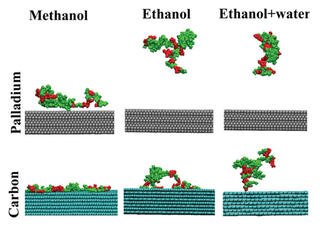Molecular dynamics simulations reveal effects of solvent on lignin-surface interactions

Background/Objective
Lignin, one of the primary components of lignocellulosic biomass, is a potential abundant source of renewable aromatic compounds. Reductive catalytic fractionation (RCF) is a promising process to produce high yields of phenolic monomers and oligomers from plant lignin. Solvent selection is key to optimizing RCF, yet understanding of solvent effects are limited.
Approach
Scientists performed all-atom molecular dynamics simulations to study lignin solvation, solvent-mediated conformational changes, and the interaction of solvated lignin oligomers with model surfaces. They focused on the behavior of a model lignin oligomer in methanol, ethanol, a binary mixture of ethanol and water, and water alone at typical RCF reaction temperature (473 K) and room temperature. Model palladium (Pd) and carbon (C) surfaces were introduced to understand how solvent choice impacts adsorption onto a representative catalytic surface and to quantify competition among reactant and solvent molecules for surface binding sites.
Results
Unbiased simulations suggest strong adsorption of lignin on both Pd and C surfaces at 473 K with notable solvent-mediated differences in adsorption energies. Free energy calculations further indicate that lignin adsorption is promoted by the entropy change resulting from displacement of solvent molecules from the surface. Results suggest that ethanol and ethanol/water mixtures are preferred over methanol in driving lignin solvation and surface adsorption.
Impact
Findings provide molecular insights into the way that solvent choice influences catalytic reactions — a step towards understanding and optimizing the catalytic conversion of lignin — and highlight the need to consider both solvent effects and catalyst structure when designing RCF processes.
Rajbangshi, J., Sener, C., & Van Lehn, R. C. Effect of Solvents on Lignin–Surface Interactions via Molecular Dynamics Simulations. The Journal of Physical Chemistry B, 129, 9175–9189. (2025). [DOI:10.1021/acs.jpcb.5c02943]